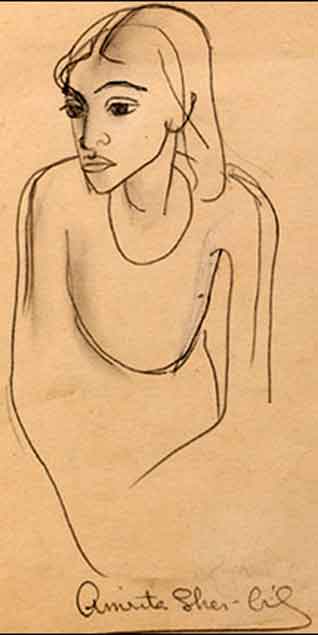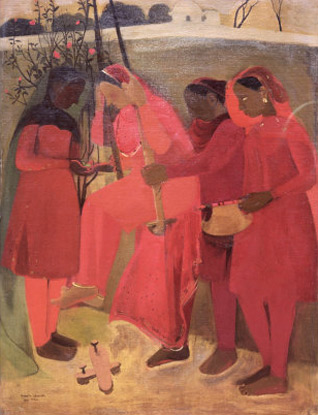Art
Remembering Amrita Shergill
NOOPUR TIWARI
“The quality of art in our country [India], particularly the apathetic attitude of the public towards the fostering of a cultural renaissance, is depressing.” – Amrita Sher-Gil, 1937, The Tribune
Words of the 24-year-old Sikh-Punjabi artist returned from Europe, scathing in her criticism of the Indian art milieu that she had made her own.
It’s easy to see why Amrita Shergill’s strong persona dominates most of the discussion around her work. Her contribution to the subcontinent's art was historic, but “the grande dame” of art barely lived long enough to paint for a decade as an adult.
The latest tribute for Amrita Shergill’s birth centenary this year was in Paris, the city where she spent most of her formative years.
Remembering Amrita opened at the UNESCO headquarters with photomontages and films brought in from both India and Hungary. Photos taken by her father Umrao Singh Sher-Gil, and her Hungarian maternal uncle, the Indologist Ervin Baktay, were also featured. Digital reproductions of her works from the National Gallery of Modern Art (NGMA) were displayed and her letters (published in 2010 by her nephew Vivan Sundaram) were quoted.
Paris was Amrita’s real introduction to the vibrant art scene in the “West”. She had been sketching and painting since she was a child, first in Punjab and across the subcontinent and then in Hungary, but she took her formal training at the École des Beaux-Arts in Paris.
During this phase, Amrita discovered Indian art at the Musée Guimet and later took the decision to live and paint in India. Her niece Navina Sundaram, who curated one part of the Paris exhibition, says, “She was 16 when she came to Paris and had artist friends in Montmartre. It was an exciting time for her and she matured here as a person. She returned to India in 1934 and then paved the way for all those who came later, including the Progressives such as MF Husain, Akbar Padamsee and Krishen Khanna, who have acknowledged her influence.”
Amrita recalled in 1936 how she began to be “haunted by an intense longing to return to India, feeling in some strange inexplicable way, that there lay my destiny as a painter”.
But this was perhaps not as strange as Amrita said it was. In the same article, she recounts how her French professor Lucien Simon thought that the richness of her colours would find their “true atmosphere in the colour and light of the East” as she wouldn’t quite fit in the “grey studios” of the West. In this way, Amrita was shown a mirror to her own “otherness” in Europe. She probably did rejoice in her return to her Indian roots, but she was also utterly isolated in her unique Euro-Indianness here.
Beyond the opulence of her bourgeois lifestyle and the fiery glamour of her beauty and sexual proclivities lies the conflictual tension of her artistic identity. The much celebrated duality of the “East and West” in her work must neither have been easy to manufacture, nor a harmonious blend. Her aggressive and acutely self-conscious stance on how she defines art in her writings also stems from the fact that she was both an insider and an outsider, struggling to carve a distinct path for modern Indian art.
As Geeta Kapur, art historian and critic, says, “The relationship between the notion of tradition, nationalism and modernism was special in India’s post-colonial context.”
Amrita was acerbic in her criticism of the Indian art of her times, dismissive of the Bengal and Bombay schools. She thought Indian art was impoverished by its “cheap emotional appeal” and had “committed the mistake of feeding almost exclusively on the tradition of mythology and romance”.
With the exception of Tagore, who she thought painted well even if he wrote “piddling poetry”, and Raja Ravi Varma, whose style she occasionally liked, Amrita felt everyone gave in to “servility” in art. She saw herself as an individualist evolving a new technique that would be “fundamentally Indian in spirit”. Sadly, she died very young, leaving her project unfinished.
Some call Amrita “the Frida Kahlo of India”. What the two women had in common apart from their Hungarian-Jewish connection was perhaps how the so-called indigenous streak in their pioneering work stood out from what their contemporaries were doing.
Artist Nalini Malani says she strongly identifies with both the artists even though they are quite different. She points out how Frida’s paintings reflected her Mexican heritage right from the start and she was so politically inclined that she wanted to change her year of birth from 1907 to 1910 so that people would make an association with the year of the Mexican revolution. She identified with the Mexican people and wore clothes that would bring her close to the working class.
Amrita, on the other hand, had her servants pose for her and hold her canvas or umbrellas as she painted. “Amrita identified more with the gentry and the upper crust of Indian society,” says Malani.
In her earlier works depicting the poor of India, Amrita borrows Paul Gauguin’s style of painting Tahitians.
“Gauguin provides a way for her to negotiate with this representation of the Indian body,” says Deepak Ananth, an art historian based in Paris who believes “she makes the connection between Tahiti and India because they are both non-European cultures”.
But Amrita goes on to say in one of her letters how her painting Child Wife was “too influenced” by Gauguin and that she had to try and move away.
She said, somewhat naïvely, that she wanted to paint the poor, who were “strangely beautiful in their ugliness”. This was no doubt a European influence, but painting poor subjects was perhaps also her way of appropriating a way of being that was antithetical to her own. Painting with these models in the garden or the kitchen was perhaps a welcome break from the luxurious but stifling life she led on her father’s estates.
Yet it’s hard to detect any trace of torment in Amrita’s work. The striking stillness and calm of the poor she portrays makes one wonder whether she communicated with her models at all. Amrita was perfectly fluent in English, Punjabi, Hungarian and French, but was still trying to learn basic Hindi.
Art historian Katalin Keserü attributes this lack of upheaval in her depiction of poverty as an influence of Hungarian artist Szőnyi István (1894-1960) who painted peasants standing in front of the house in a quiet, harmonious way.
Amrita Shergill lived in times of great turmoil.
Hitler came to office when she was in Europe, India was in its final years of its struggle for freedom when she came to live here and the threat of the Second World War prevented her from living in Hungary with her husband.
It still remains a mystery, however, as to what Amrita’s political views were.
[Courtesy: Tehelka. Edited for sikhchic.com]
October 8, 2013






